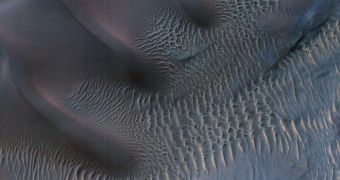A group of investigators from the NASA Jet Propulsion Laboratory (JPL), in Pasadena, California, says that the High Resolution Imaging Science Experiment (HiRISE) instrument aboard the Mars Reconnaissance Orbiter (MRO) was recently used to image amazing landscapes on the surface of Mars.
HiRISE is one of the most capable imaging cameras on any spacecraft in existence today. It can make out structures as small as a meter (3 feet) in diameter from hundreds of kilometers above the Martian surface, and mission controllers at JPL are using it to map the Red Planet.
Over the years, the MRO has been used for mapping and imaging Mars, as well as for relaying signals emitted by the Mars Exploration Rovers and the Phoenix Mars Lander missions back to Earth.
These tasks took it over much of the planet, which enabled it to observe a variety of landscape features. In this particular image, the JPL team explains, the dunes and ripples that grace the planetary surface have aesthetic value as well, in addition to the intrinsic scientific value of the photos.
The wind-sculpted features look amazing in the newest HiRISE views. The ripples are of various shapes and sizes, and lie around the rims of a former impact crater, in the Noachis Terra region of southern Mars.
What caught researchers' eyes immediately was the fact that the area appears to have a very rich sedimentary history. There are telltale signs indicating that dunes in the region eroded in specific patterns, and signs of deposition have also been identified during past fly-overs.
Since it started orbiting the Red Planet, back in 2006, the MRO used the HiRISE instrument to snap more than 20,600 pictures of the Martian surface. Most of these datasets can be found on the camera's website, which is managed by the University of Arizona (UA) Lunar and Planetary Laboratory.
“Now in an extended mission, the orbiter continues to provide insights about the planet's ancient environments and about how processes such as wind, meteorite impacts and seasonal frosts are continuing to affect the Martian surface today,” a JPL press release explains.
JPL manages the MRO mission for the Science Mission Directorate, at NASA Headquarters, in Washington, DC. The Lab itself is managed for the American space agency by the California Institute of Technology (Caltech), in Pasadena.

 14 DAY TRIAL //
14 DAY TRIAL //